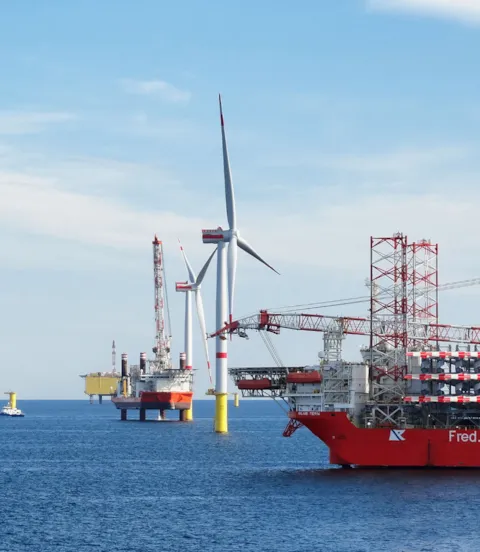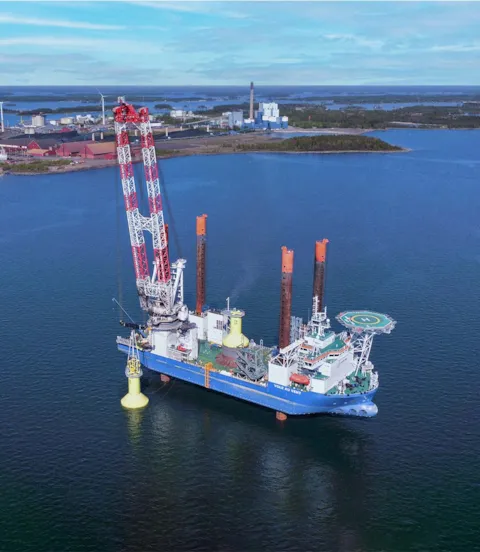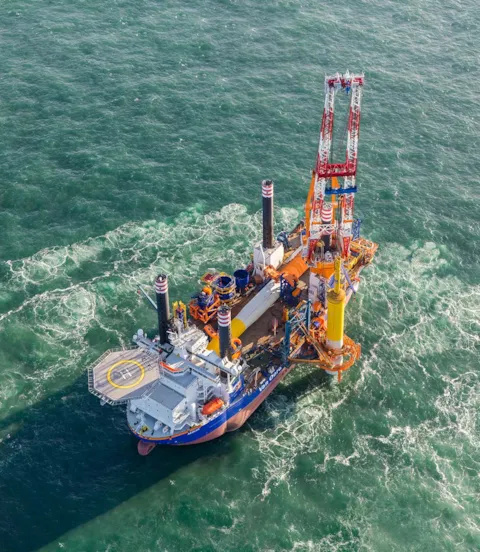Offshore wind JIP lays ground for jack-up installation standards as industry expands
Together with the industry, DNV has developed a new theoretical framework that enables safe installation of offshore wind turbines in more challenging environments. The work is the result of the first phase of a joint industry project (JIP) on Bottom Impact and Partially Submerged Conditions. New partners are invited to join Phase 2, which will focus on validating models and establish common best-practice guidelines.
Offshore wind turbine installation is today only done in very benign weather conditions due to the risk of severe impact of the wind turbine installation vessels’ (WTIVs) legs with the sea bed, leading to structural damage to the vessel or cargo.
If the weather deteriorates, vessels have to wait until conditions improve before work can resume. “However, high day rates make delays very costly and there is rising pressure to widen the weather window to undertake projects more efficiently as the industry gradually moves further into new territory with harsher weather and less forgiving seabed (soil) conditions,” says JIP steering committee chairman Andries Hofman of GustoMSC.
In addition, regions exposed to earthquake risk also require new operation philosophies such as operating the crane with the WTIV in a semi-jacked condition.

JIP heralds common approach to WTIV safety and performance
The absence of class guidelines or good models to fully understand and estimate bottom-impact forces and operations in the semi-jacked condition triggered the formation of the JIP in November 2020. “The aim was to investigate WTIV operational limits and potential new operational philosophies.
Reducing installation costs is key to bringing down the levelized cost of offshore wind energy amid the drive to boost energy security. But in a process-driven industry where time is money, pushing the boundaries founded on proper knowledge is crucial. Doing so based on limited data is very risky,” says Hofman.

Work carried out in Phase 1
With input from all JIP participants, DNV developed a numerical model to accurately predict bottom-impact forces. This allows operators to assess the sea state limit in each situation for safe lowering of the jack-up legs, without the risk of damaging the vessel, the cargo or the environment or endangering crew. It applies to both existing and new WTIVs, ensuring right from the design stage that vessels can operate within a reasonable range of conditions.
“The developed numerical model incorporates vessel heading, weather and soil conditions, as well as the strength of the WTIV, to potentially expand the weather window where the WTIV can be safely installed,” says JIP project manager Antonio Goncalves, Business Lead, Technical Advisory at DNV. “Harder soil generates more impact than soft soil, while stronger winds and higher waves can exaggerate impact events. Deeper water also causes vessels to behave differently versus shallow water. Geotechnical, hydrodynamic and environmental conditions have to match a given WTIV’s structural capabilities.”

Is operating in semi-jacked condition feasible?
The JIP also considered WTIV loads and motions in a semi-jacked condition, i.e. legs supported on the seabed and the hull in partial submerged condition. This is applicable especially in regions exposed to earthquake risk where contractors prefer the WTIV hull to be as close to the water surface as possible.
“Currently, a number of challenges exist with regard to (soil) liquefaction and acceleration/displacements while lifting the turbine and installing bolts. One needs to consider motions of the tower and turbine as well as the vessel. If we cannot find a balance between motion and foundation investment, semi-jacked operation might come with safety challenges. The problem needs further engineering calculations and we look forward to appropriate guidance from DNV in the future,” says Benjamin Haak, Marine Expert at RWE Renewables.

Full-scale instrumentation measurements can validate model output
Predictive simulation is, however, only one dimension of the challenge in achieving a final solution. Another dimension is applying full-scale instrumentation (sensor) measurements to validate model output for real conditions. “The predicted forces have not yet been correlated against actual measured forces from live operations. This is a key area where major strides can be made to improve WTIV operability,” says Goncalves.
The third dimension is documenting the role of safety factors on the probabilities of structural failure. The JIP concluded that the probabilities of structural failure can be relatively high under certain conditions. “We have achieved great insights into simulations and the effect of different parameters, but we still need more insights into the appropriate safety factors needed to ensure safe operations. With more insights from the validation of theoretical models and appropriate safety factors we will get enormous benefits from increased operational efficiency, new operation philosophies, new designs, etc,” says Goncalves.

Phase 2 in the pipeline will provide even more value
DNV is currently preparing a proposal for a second phase of the JIP. The scope provisionally includes calibrating both the bottom-impact and partially submerged models, calibration of safety factors, improving the soil model, further evaluation of crane boom/hook motions in the partially submerged condition, use of motions criteria when going on location and developing related guidelines.
“With such strong team collaboration, I am very confident that the next phase will provide even more value for all parties,” says Goncalves. “Our aim is to outline a complete safety-factor approach using real data to benchmark the model so it can be used as recommended best practice on a level playing field,” says Hofman.

Reassurance on data sharing and confidentiality
To ensure reliability of the numerical models, data is required from multiple assets working both in fair and rougher weather, from developers/contractors on site soil conditions and potentially even from turbine suppliers. Jan Sand Schanke-Jørgensen of Fred. Olsen Windcarrier says there is high industry interest in getting the full picture, even as new vessels join the market. “For example, if vessels are shown to be over-dimensioned the inclusion of less steel could reduce building costs while allowing more equipment on deck. Lowering emissions is also a key factor in making the entire installation ecosystem as efficient as possible.”
Although providing data has a clear business case in terms of improved WTIV operability and damage prevention, there is residual concern as to what might happen with proprietary data once shared. Goncalves stresses that all data will be treated as confidential by DNV, and only the developed guidelines will be shared.

Participants express enthusiasm for “creative arena”
There was unanimous appreciation of the JIP process. Positive feedback included the following: “It’s fantastic to sit down and talk over important topics without being commercially driven internally. Focusing on safety-critical issues for our crews, assets and the environment is why this is successful,” said Sand Schanke-Jørgensen.
Kevin van de Leur, Lead Engineer at Van Oord Offshore Wind, said: “We have done this kind of site assessment analysis before, but it’s difficult to do properly alone. Working together we can develop a common industry standard that everyone is confident about.”
Eric Romeijn, Manager R&D at Huisman Equipment, added: “We consider simulations of bottom impact as crucial to further optimize Huisman’s next-generation jacking systems for offshore WTIVs. We expect further benefits of a second JIP phase contributing to safe and reliable jack-up operations.” Fu Qiang, director of CIMC Raffles’ R&D centre, as well as director of the marketing centre voiced similar sentiments. “We are proud to have participated in this JIP and look forward to continuing the work,” he said.
Eduard Lopkov, WTG Installation Senior Lead Specialist, EPC & Operations, at Ørsted, adds that as a major value-chain stakeholder Ørsted is quite selective about the JIPs its joins. “But this one has the potential to markedly improve operations, having shed light on an area not sufficiently explored previously. We can use our combined knowledge to create solid standards and a reliable predictive model that can make jack-up installations safer while reducing the weather downtime factor.
In terms of a level playing field, having uniform guidelines will make the sourcing process easier. This applies both to winter and summer operations and seabed conditions, where we already see projects move from sandbanks to more challenging sites with heavy clay and rocky soils, and deeper water. In terms of data sharing, DNV has an excellent record in managing proprietary data. We look forward to the next stage to develop specific guidance that will benefit everyone.”

Knowledge sharing is the best format
The JIP work will be relevant for a long time to come, as bottom-fixed wind farms requiring jack-up installation will remain most cost-attractive to diversify our energy mix. “The market is developing quicker than the rules and the only way to make significant leaps is through sharing knowledge,” says Goncalves. “Our aim is to formulate solid recommendations that are easily accessible. Through better understanding of what forces are at play for a specific site, and their consequences, we can increase performance and safety in worse sea conditions, enabling more efficient and timely turbine installation, which is a great opportunity for the whole industry.”

Door wide open for new partners
Goncalves emphasizes the JIP is open to more partners, be they energy companies, installation contractors, designers and shipyards, crane fabricators or wind turbine manufacturers. General benefits include reducing the risk of project delays, accidents and damage to installed equipment, reducing transaction costs, ensuring specific concerns and objectives are considered in the guidelines, and last but not least the opportunity to network with domain leaders.
Please reach out to Antonio.Goncalves@dnv.com to signal your interest and find out how your organization can benefit specifically.
Project partners: DEME Offshore, DNV, EDF Renouvelables, Fred. Olsen Windcarrier, GustoMSC, Huisman Equipment, Jan De Nul, Ocean Winds, Ørsted, RWE Renewables, Seajacks UK, Van Oord Offshore Wind, Yantai CIMC Raffles Offshore.

Antonio Goncalves
Business Lead
- Fred. Olsen Windcarrier
- Jan de Nul Group
- DHSS
- Van Oord
- DEME Group/VAN DER KLOET